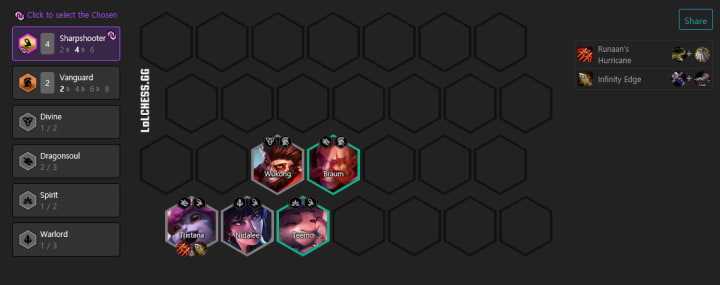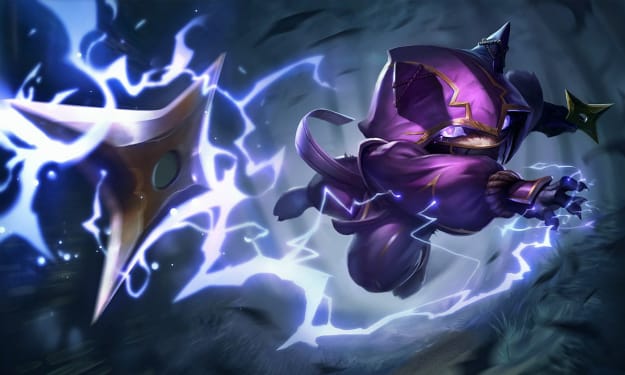TFT Guide: Top 3 Mistakes to Avoid to Improve Your Gameplay
A Teamfight Tactics Gameplay Guide

This week’s TFT guide will focus on three mistakes to avoid making to improve your TFT gameplay. We’ll look at the importance of a strong economy, why you need a game plan, and my number one tip for improving at TFT.
#1: Rolling Too Much/Not Enough
There’s a sweet spot on how much you roll. Keep in mind that different comps want to roll at different stages, but there are some useful heuristics you can keep to. At low levels, you almost never want to roll unless you’re playing a reroll comp. You’ll rarely roll at level 6, and most of your big roll downs will occur at levels 7 & 8.
You roll to make your board stronger. What this means varies wildly from game to game, but you’ll generally be trying to 2-star important units or fill out your traits. Sometimes you’ll be looking for a specific unit, like the third Lulu for your mage comps. Other times, you’ll be hunting for something a little less specific like a frontline tank so your backline can do its thing. One easy tip to avoid spending excess gold on rolling is to only roll if you need to get stronger.
An easy way to preserve gold is to roll with a plan. If you’re rolling just because, you’re going to waste a bunch of gold. You don’t need to be chasing a single unit, but understanding you need to hit your sixth Brawler or your secondary carry can both be valid reasons to roll. Think about what your board needs to get stronger before rolling.
Another tip to help preserve gold is try to roll for multiple units at once. If you’re only rolling for a two-star Wukong, you might want to wait a bit before rolling. But if you’re holding onto Wukong, Irelia, and Jax pairs as well as looking to upgrade your Kindred, that’s a great spot to roll because it makes it far less likely that you won’t hit the units you’re looking for, wasting your gold.
A final tip to avoid losing too much gold is to never roll below ten gold, although twenty is an even better threshold. The interest gold you accumulate over the course of the game is a consistent way to increase your economy and rolling below ten makes it harder to catch up to the rest of your lobby. If you’re in the last few rounds of the game, not rolling below ten becomes a little less important as you can’t take it with you into the next game. But keeping your gold stores high is vital. The easiest way to lose a game of Teamfight Tactics is to wreck your economy during the midgame by either rolling to 0 or aimlessly rolling throughout the stage.
Now that you know how important it is to have a bunch of gold, it’s tempting to hold onto it like Ebenezer Scrooge. But that can also send you down a dangerous path. If you never roll, you’ll be significantly weaker than players who do. Typically, everybody goes level 7 around 4-1 and level 8 around 5-1, rolling down at these stages. These stages represent power spikes where the field gets a lot stronger, and the one player who doesn’t roll falls behind and takes a ton of damage.
As for rolling at 6, you aren’t going to do this every game. It’s a judgment call on the relative strength of your board. You want to be strong enough that you aren’t losing to 4 or 5 units every round while ensuring you’ll have enough gold to level up and roll on 7. I probably roll on 6 one out of every four or five games. This is again, however, unique to your situation. The best advice I can give you on rolling is to make sure you understand when you have to roll to get stronger and know what you’re looking for.
#2: Playing Without A Plan
This is a big one. If you play the game without a plan, then you’ll arrive in the late game with a smattering of units and disjointed items, and that Olaf player who has been streamlining their comp and building perfect items since Krugs is going to stomp you into the dirt.
In most games, I determine my game plan by evaluating my items after Krugs. If I end Krugs with a Rapid-Fire Cannon, a Belt, and a Sword, I’m in a good spot to play Kayle but probably don’t want to try playing Fabled. Determining your final comp allows you to slam items early so you can win streak and pick the perfect early and mid-game carries.
Having a solid game plan is good but can also be a burden if you refuse to be flexible. Continuing our example with Kayle, let’s assume you slam the Zeke’s and pick up a Sword from the 3-4 carousel. Then Wolves drops a Sword, a Cloak, and a third Bow. Suddenly, you have great Olaf items with RFC, Runaan’s Hurricane, and Deathblade. You could continue to play Kayle here and try to make those components into some combination of Guardian Angel, Rageblade, and Quicksilver Sash, but I’d pivot towards Olaf and away from Kayle. You have better Olaf items, and picking this route allows you to slam all of your components now for a power spike in Stage 4.

Other benefits to having a game plan are holding the right units on your bench and slamming items early. Here’s a hypothetical situation: It’s 2-5 and your strongest board is a Vanguard Frontline supported with Sharpshooters and Chosen Tristina. You know from your items that your end game is going to be Olaf carry, so you slam Runaan’s and Infinity Edge on Tristina. Because you slammed your items, you win streak, gain a large health advantage, and a ton of extra gold. As you play through the rest of Stage 2 and into Stage 3, you roll a few Pykes in your natural shops. Because you know that your endgame is Slayers, you can pick those units up now and have a Pyke-2 when it’s time to transition.
Composing a game plan takes a lot of practice. You need to understand what late-game compositions look like and what items different late-game carries want. A few simple tips at this stage are to make sure you always play your strongest board and to make items that work well together. Having a game plan also helps you roll correctly. If you know what you’re looking for because you have a game plan, it’s easier to roll purposefully and avoid wasting gold. Now, for the last tip. This will probably help elevate your game more than any other and is the one I still struggle with the most.
#3: Blaming Your Losses on Luck
You don’t have control over a lot of situations in TFT. You don’t get to pick your item drops or the Chosen in your shops. A lot of gameplay is about mitigating that variance. You make sure to have gold to roll so you can increase the odds of finding the units you need, and you build game plans around your item drops. But sometimes the variance flips you the bird, and your game is over. I had a game where every item I dropped on Krugs and Wolves were Tears and Rods, I couldn’t upgrade my carries, and got a quick seventh. It happens.

It’s easy to look at a game of TFT, especially one where you just barely went fifth, shrug, and say, “I lost to bad luck. If I had found that Chosen a turn sooner or if I been paired against another player….” There are dozens of tiny little instances where a touch more luck could have gotten you that top four. But when you look at the game like that, you’ll miss the little instances where you could have improved your game. Maybe you could have lived an extra round if you had positioned your Shyvana away from their Lee, or you had moved your Viegar over so Aatrox didn’t pull him.
The point here is that if you look at most games and think, “I needed to get lucky,” you won’t learn nearly as much to make the next game better. You’re rarely going to have games where you hit the perfect champions and items at the perfect times, but you will still high roll, and you will low roll sometimes. The best way to improve as a player is to play around the variance. Figure out how to maximize what you’ve been given. Once you can divorce yourself from the idea that every loss comes from bad luck and every win comes from your skill as a player, you’ll be able to elevate your gameplay to a new level.
If you enjoyed what you read here, check out myTFT guide: How to play Keeper-Kennen!





Comments
There are no comments for this story
Be the first to respond and start the conversation.